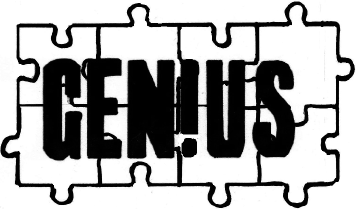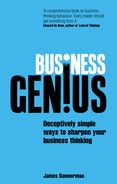The fourteenth Block and Limitation to Business Genius is careless collaboration.
And it’s often careless for two main reasons:
- People are careless about the way they collaborate with others (which often leads to conflict).
- People couldn’t care less about collaborating with others (which often leads to missed opportunities).
Let’s take a closer look at the second.
It’s hardly surprising – in the real world of work – that not everyone welcomes collaboration with open arms.
After all, collaborating with others can be extremely time-consuming (if you’re constantly having to ask for everyone’s opinion on everything), and it can also be extremely irritating (if others have a propensity to ‘park their tanks on your lawn’!)
That aside, however, it doesn’t take a Genius to realise that when collaboration does work well, the business benefits are often far greater than the sum of the parts.
Look at the business collaboration that first started in 1904, for example, when Henry Edmunds introduced two people to one another (at a Manchester hotel), thinking they might get on: one was an engineer called Henry Royce, and the other a businessman called Charles Rolls.
Or look of the business collaboration that first started in 1837 when a man called Alexander Norris floated the notion that the husband of one of his daughters (Olivia) might be better off working with the husband of his other daughter (Elizabeth). One was called William Procter (who made candles for a living), and the other was called James Gamble (who made bars of soap).
Effective collaborations can often spark moments of Business Genius that probably wouldn’t have happened on a solo basis (from Elton John and Bernie Taupin to Marks & Spencer, and even the iconic Concorde).
Unfortunately, however, although ‘many leaders inherently know that in today’s competitive environment companywide collaboration is imperative for successful strategy execution’ – as collaboration expert Morten Hansen observes – there’s frequently a hairy old troll guarding the bridge: and that troll is office politics.
That’s to say, what’s good for a business might not always be perceived as good by the individuals in that business. Consequently, this can lead to all kinds of non-collaborative behaviours from important information not being shared, to traditionalists and progressives ending up at loggerheads with one another and, worst of all, trust breaking down.
With this in mind, if you want to UP! your collaboration and work jointly on an activity or project it’s important to realise that collaboration is simply a conflict management style. Or, more specifically – as Kenneth Thomas and Ralph Kilmann pinpointed in 1974 (in their research tool, the Thomas-Kilmann Conflict Mode Instrument) – simply one of the five conflict management styles, which include:
- Competing: like boxers in a ring, where there’s a winner and a loser.
- Compromising: where both parties win a bit, and lose a bit.
- Accommodating: where one person backs down to let the other win.
- Avoiding: where both parties ultimately end up losing.
- Collaborating: which is the all-too-familiar win–win scenario.
Although this might sound pretty obvious, however, here’s something that’s perhaps a little less obvious. In terms of the Thomas-Kilmann model, collaboration turns out to be the complete opposite of avoiding. After all, ever tried to collaborate with someone who is as elusive as the Scarlet Pimpernel? That’s why the secret of effective collaboration is inclusivity (i.e. drawing the pieces of the jigsaw closer together) rather than exclusivity (i.e. pushing them further apart) …


UP! YOUR COLLABORATION
NUGGET
When the legendary rock band the Eagles wrote Hotel California back in 1976, it was a classic example of collaboration in action.
To begin with, it started out as a guitar riff created by Don Felder (who was evidently a great guitar player, but not much of a singer).
Then – using Felder’s rough demo tape as a foundation for the song – fellow band members Don Henley and Glenn Frey began to embellish it.
But that wasn’t the end of it.
As the songwriting and recording developed, the infamous long guitar solo at the end – featuring Felder and co-guitarist Joe Walsh – emerged out of the two desperately trying to outplay one another because of their intense rivalry. And this was a sign of things to come …
The purpose of this nugget is simply to demonstrate how collaborating isn’t always easy, and it isn’t always painless, for, by 1980 – when the Eagles had become the biggest band in America – there were so many fights and hostile exchanges of words, they finally split up. More to the point, they were so angry with one another, they promised their fans they would only play again, ‘When Hell freezes over!’
So, what happened?
Well, 14 years later they started to collaborate again and recorded another hit album called … Hell Freezes Over.
Genius!


USEFUL TIPS AND
ESCAPE STRATEGIES
If you want to UP! your collaboration, here are three practical tips and strategies that can help:
1 PICTURE AN ORANGE
I once stumbled across an intriguing insight on conflict resolution by the US business consultant Bob Lapin.
Lapin told the story of two young boys (brothers, to be precise) who kept squabbling over an orange because they both wanted it, and there was only one available.
Eventually, having bickered and argued for so long, they ran up to their father to make the final decision on who should have it.
So what does he do?
Well, the standard answer is, ‘Cut it in half!’ (compromise). Perfectly logical; perfectly fair.
‘No,’ says Lapin. ‘The father asks them why they want the orange.’
One says, ‘Because Mummy says they’re good for me and they’re full of Vitamin C,’ and the other says, ‘Because I want to make Mummy an orange birthday cake.’
So the father ends up giving the fruit to one, and the peel to the other.
Anyway, the point of the story is – as you can no doubt tell – often in business it can be highly tempting to go straight for the compromise, but it’s only when we listen and find out what the real issues are that we can make an informed decision.
2 WELCOME ‘CREATIVE ABRASION’
This one’s far from easy, because when people get on our nerves or wind us up at work, the prospect of collaborating with them is usually the last thing on our mind.
In psychology, however, there’s a phenomenon called creative abrasion, which sheds light on how a little bit of friction and tension (in a group dynamic) is often no bad thing.
Or, to follow on from the Eagles example earlier: ‘A bit of craziness,’ as Eagle’s guitarist Joe Walsh once said, can be useful for ‘fanning the artistic fire’.
Please don’t think, however, that creative abrasion has relevance only in the world of rock.
It is also relevant for virtually any business, or business team, because without creative abrasion there’s always the danger of groupthink. Put simply, groupthink – a term the psychologist Irving Janis invented in the 1970s – occurs when people value consensus over and above the fixing of problems.
One of the most famous, and tragic, examples of this was when the NASA Challenger blew up. After the event, it turned out that many individuals working on the programme had silent reservations about some of the technical safety issues but, when they were in a group context, they kept these thoughts to themselves because they didn’t want to be seen as troublemakers, or negative influences on such a positive and pioneering journey into space.
Within the context of your own collaborations you may want to reflect upon what thoughts are not being said, for pretending everything is hunky-dory (when it isn’t) seldom helps anyone in the long-run.
3 VIEW COLLABORATION ‘REALISTICALLY’
One of the great ironies of collaboration training programmes is that the people who come on them tend to be fairly collaborative anyway. It’s the ones who stay away (either because they’re too busy or because something’s cropped up) that, arguably, need to be there the most.
That said, however: it’s important we view collaboration realistically (rather than idealistically).
The bottom line is that we can’t make other people collaborate (even if we’d like to). Of course we can have a good try – by using all the tools, techniques and insights under the sun – but, at the end of the day, if they don’t want to collaborate, they won’t. Far better that we focus on the difference we can make to our part of the collaborative process, because by osmosis that can help to change the overall dynamic.
Another part of viewing collaboration realistically, however, involves accepting that sometimes – if the co-operative spirit just isn’t there – it could be time to shift direction. Back in the late 1940s, for example (in the German town of Herzogenaurach, Bavaria) two brothers weren’t just bickering over an orange; they were finding it hard to collaborate on their joint business. So what happened? Well, Adolf Dassler set off to set up Adidas and, on the other side of the road, Rudolf Dassler set up Puma!

BUSINESS GENIUS IN ACTION:
NEXT STEPS …
In summary, if you want to UP! your collaboration, here’s how:
- Pinpoint how collaboration is ultimately a conflict management style (and, like competing, compromising, being accomodating and avoiding, it can work well in some situations, yet less well in others).
- Investigate what an amazing difference collaboration can make (from Rolls-Royce to Procter & Gamble and Lennon and McCartney to Goscinny and Uderzo (the creators of Asterix). This, in turn, can then inspire you to develop dynamic business collaborations of your own, based on the principle that the whole is often greater than the sum of its parts).
- Leverage the power of inclusivity (because it’s incredibly hard for collaboration to work well when people are as elusive as the Scarlet Pimpernel!).
- Orchestrate a plan to heal rifts (for, although it doesn’t always work, the Eagles managed to do it when they finally reunited in 1994).
- Target oranges (or at least remember the story of the orange mentioned earlier, for it will help to remind you that racing ahead for a quick compromise may often be the easiest business option, but it’s not always the wisest).

UP!SPIRATION
‘If everyone is moving forward together then success takes care of itself.’
Henry Ford (founder of Ford Motor Company)
